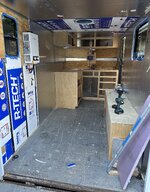Laelkhunter
WKR
Not to pick nits, but it's a CO detector (Monoxide) not CO2 (dioxide). Make sure you mount it low, about 12 inches from the floor. CO sinks and saturates the air low at the floor then rises as it saturates the air and fills the area. If you mount the CO detector high (on the ceiling) like you do a smoke detector, it might never register the dangerous amount of CO at the level that will affect you (like when you are sleeping on a cot 24" off the floor).

